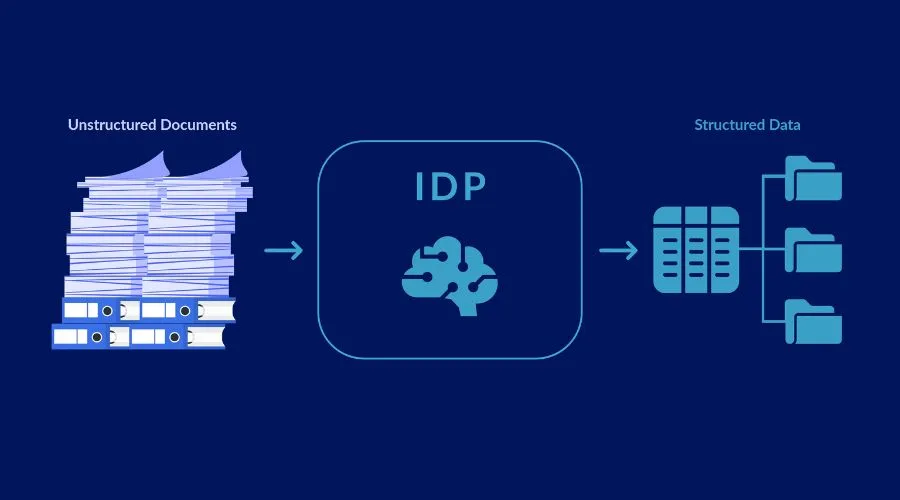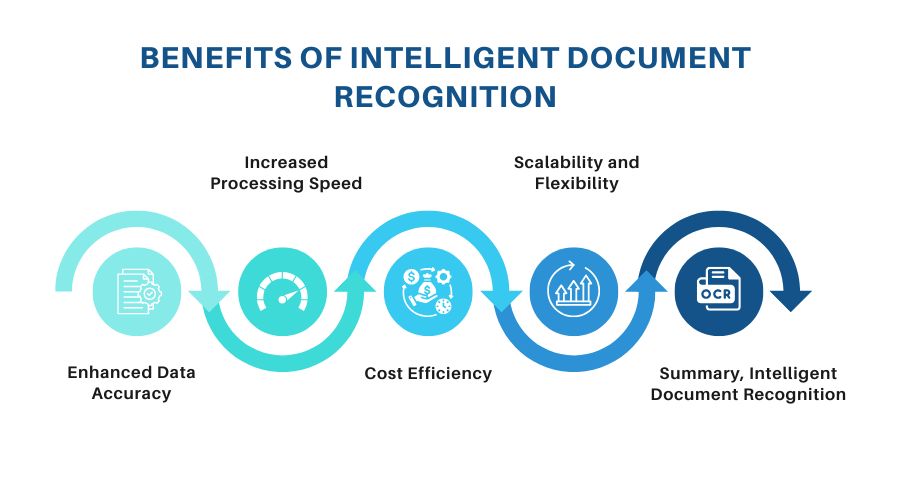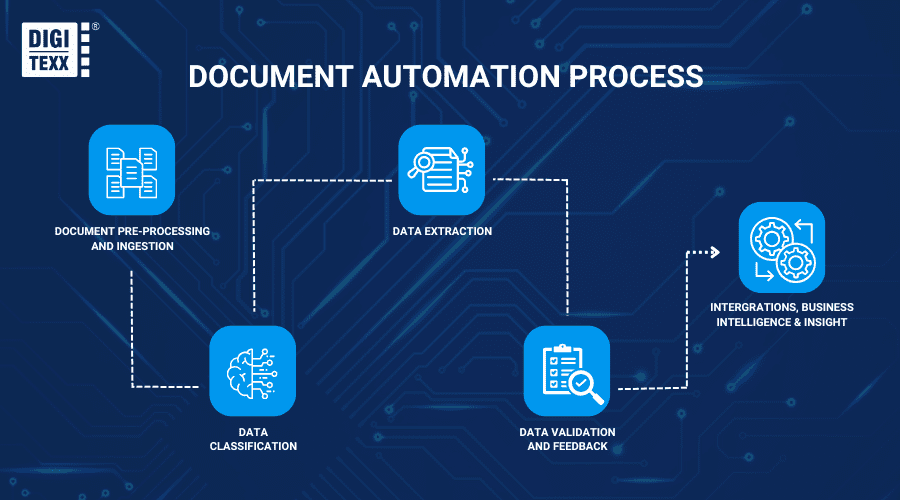Intelligent Document Recognition (IDR) or Intelligent Document Processing (IDP) is a technology that can be trained in up to 190 languages and is capable of reading and interpreting documents much like a data processing worker would. Let’s explore this further with DIGI-TEXX in the following content.
=> See more: The Benefits of Partnering with Document Processing Companies

What is Intelligent Document Recognition?
Intelligent document recognition (IDR) is a component of intelligent document processing (IDP) technology. Before extracting and processing data from documents, Algorithms must correctly classify them (e.g., as invoices, balance sheets, bank statements, etc and recognize ‘intelligent’ – Rather than simply matching documents to preconfigured templates, IDR can contextualize the nuances in each document.
Intelligent document recognition (IDR)
Core Principles of IDR
From different types of documents, IDR systems use machine learning algorithms to analyze, recognize, and extract key information. Then examine the structure, content, and context of each type of document to ensure that data is classified and extracted accurately. With continuous training, IDR systems improve over time, becoming more efficient in processing complex documents.
Key Features of IDR Systems
IDR systems usually combine OCR for text recognition, machine learning models for extracting data, and advanced validation methods. These systems automatically sort documents and extract the necessary information, ensuring fast, precise processing while integrating with other software to streamline workflows and boost productivity.
Benefits of Intelligent Document Recognition
IDR systems not only speed up and improve document processing efficiency, but also reduce errors and optimize costs for businesses. IDR helps improve data accuracy and streamline workflows by automating complex manual tasks, allowing businesses to handle more work without needing extra resources. This technology is especially valuable for industries that manage large volumes of documents.

Improved data accuracy
By applying IDR, businesses can achieve high accuracy in document processing. The technology not only reduces human error, inconsistencies to ensure that the extracted data is reliable, especially in industries such as finance and healthcare.
Significantly Speeds Up Processing
IDR significantly speeds up document processing for businesses by automating tasks such as data extraction and classification. The system’s attempt to reduce this manual effort results in shorter turnaround times and faster decision making. As a result, businesses can confidently respond to customer requests and complete transactions quickly, improving efficiency especially in overall service delivery.
Highly Cost-Effective
By reducing the need for manual intervention with high human resources as before, the IDR system helps companies cut down on this expense. Not only that, automating document-related processes also helps minimize the risk of costly errors. By applying IDR technology, businesses can allocate resources effectively and save more costs over time.
Flexibility and Scalability
The flexibility and scalability of the IDR system allows for applications suitable for many different industries, typically the industrial sector with a variety of document types. As the business grows, IDR can handle huge volumes of documents, ensuring no reduction in performance.
In addition, IDR also provides the ability to customize the workflow, helping businesses easily adjust the system to better suit changes in needs and business goals.
Intelligently identify and summarize documents
Intelligent document recognition (IDR) is a solution that helps change the way businesses operate and manage and process documents. Thanks to the combination of AI, machine learning and OCR, the IDR system helps improve accuracy, speed, and effectively cut costs, bringing many benefits to businesses.
With these advantages, the IDR system becomes an important tool for businesses that want to optimize document workflows, while supporting effective scaling of operations.
How Does Intelligent Document Recognition Work?
Intelligent Document Recognition (IDR) is the result of combining advanced technologies, including Machine learning, optical character recognition (OCR), and artificial intelligence (AI) to be able to automatically extract data, classify, and process data from various document sources. It works by analyzing, and identifying relevant information sources, and then converting them into structured data for further use.

Document Capture and Preprocessing
IDR first collects documents by scanning digital forms or uploading data files. The system pre-processes the documents to improve quality, including Noise reduction, image normalization, and text clarity enhancement. This ensures that the documents are in the best possible common format for accurate data extraction.
Text recognition and data extraction
Once the documents are processed, the IDR system uses OCR technology to recognize and extract text (including printed or handwritten content). The system identifies characters, words, and individual sentences, converting them into machine-readable data. In addition, the IDR system leverages machine learning to identify and extract relevant data points, such as invoice numbers, dates, addresses, or account details.
Automated Document Classification and Validation
The IDR system classifies documents based on predefined patterns or through machine learning models trained to recognize document types such as invoices, contracts, or receipts. Once the documents are classified, the system verifies the extracted data against established rules and patterns and conducts data accuracy validation to ensure that only relevant, accurate information is processed further.
Data Integration and Automation
After validation, the structured data type is integrated into the company’s existing systems, such as databases, enterprise resource planning (ERP) software, or some customer relationship management (CRM) tools. IDR can automate the entire document processing process, including approval processes, routing documents to appropriate departments, or setting up periodic reports, reducing the need for manual intervention.
Continuous Learning and Improvement
IDR systems are designed to automatically learn from new data sources to improve their capabilities over time. As they process large volumes of documents, IDR continuously refines its algorithms to improve their accuracy and efficiency in processing data.
This continuous learning process allows IDR systems to not only quickly process complex types of documents, but also flexibly respond to many changes in the needs and business goals of the enterprise.
In short, Intelligent Document Recognition (IDR) is the product of a combination of OCR, machine learning and AI to automatically extract and process data with many different types of documents, helping to increase speed and accuracy. This optimizes workflows, reduces human errors and improves work efficiency in the enterprise.
Intelligent Document Recognition Applications
The multiple benefits of intelligent document recognition make it applicable to multiple industries. Here are a few typical use cases:
Financial Services (Generally)
Accounts Payable (AP) departments process data from large volumes of vendor invoices. Document recognition can validate the invoice’s document type before capturing the relevant information (e.g., the invoice date, vendor details, line items, etc.).
For example, when our client Enterprise RBA receives emails, our document recognition technology automatically classifies the attached documents, which enables them to be sent to the right repository for manual review. Read the full case study here.
Annual Reports
Expanding on document recognition’s role in financial services, another valuable use case is identifying financial statements within annual reports. In seconds, AI algorithms can classify the balance sheet, income statement, and cash flow statement from a 200+ page annual report. A tedious job for an analyst – with a quick and easy technological fix.
Manufacturing
Supply chain automation can extract data from documents like purchase orders, invoices, and bills of lading – enabling regulatory checks and routing to the relevant department for further processing.
Choosing the Right IDR Solution
Among many Intelligent Document Recognition (IDR) solutions, choosing the right technology will help businesses improve efficiency and ensure accurate document processing. An IDR system that fits into a business’s existing system will help save time, reduce errors, and human errors, and easily expand when needs change.

Learn more about the following 5 key factors to choose an IDR solution for your business.
Accuracy, reliability
Accuracy is considered the most important factor when businesses choose an IDR solution. The ultimate goal is to be able to extract accurate data from document sources such as invoices, contracts or forms. A reliable system helps businesses minimize errors, ensuring data is processed more accurately.
In short, knowing how to choose an IDR system (including advanced OCR, machine learning, and self-improvement capabilities) will help IDR work with a wide variety of documents, including handwritten or scanned documents.
Time and Efficiency
Time and efficiency are two important factors in business operations. A popular document capture automation solution today – IDR provides the ability to capture documents, classify and extract data, reducing manual work. This system allows employees to focus on higher-value tasks, thereby, responding to customers, transactions and processing documents faster.
Scalability and Flexibility
Scalability and flexibility are important and necessary for growing businesses. As your business expands, the volume of documents increases and an IDR solution will help your employees handle the large workload without affecting performance. But businesses must choose the right IDR and adapt to new types of documents, as well as integrate with tools such as ERP or CRM of the business. At the same time, choose easily scalable solutions, offering customization to meet changing needs.
Cost Effectiveness
Cost is always an important factor for businesses to consider when implementing any new technology. While an IDR system can help reduce operating costs in the long run, the initial investment can be a major hurdle. Businesses need to find a solution that balances the initial cost with the long-term benefits, as well as the costs of maintenance, employee training, and system upgrades.
Data Security and Compliance
These are essential factors when choosing an automated IDR solution. Businesses must ensure that the system meets regulations such as GDPR and HIPAA with strong security features, data encryption, secure storage, and access control.
In general, choosing the right IDR solution will bring many benefits to businesses such as: Accuracy, time efficiency, scalability, reasonable cost and data security, ensuring the IDR system is suitable for business goals, supporting sustainable development for businesses in the future.
Challenges of Intelligent Document Recognition Software
Climate change has likely led to the decline of some of Scotland’s mountain plants, according to new research.

Challenges of IDR Software
Although IDR is a solution with many benefits, there are still some challenges as follows:
– Accuracy: Many IDR systems still have difficulties, especially when extracting data from complex documents such as handwriting.
– Integration: With current business systems and processes, IDR may have difficulties, especially integrating with ERP or CRM. In addition, scalability is also an issue when the volume of documents is unstable.
– Security rights: IDR will also handle sensitive information, so it also needs to comply with GDPR and HIPAA regulations.
– Initial investment costs: For many items such as Software, training, and maintenance while operating IDR.
In short, although intelligent document recognition (IDR) brings high efficiency and accuracy, businesses need to carefully consider all of the above factors before deciding to apply this technology.
| Read more:


